-
Java多线程编程【一文全解】
01 线程简介
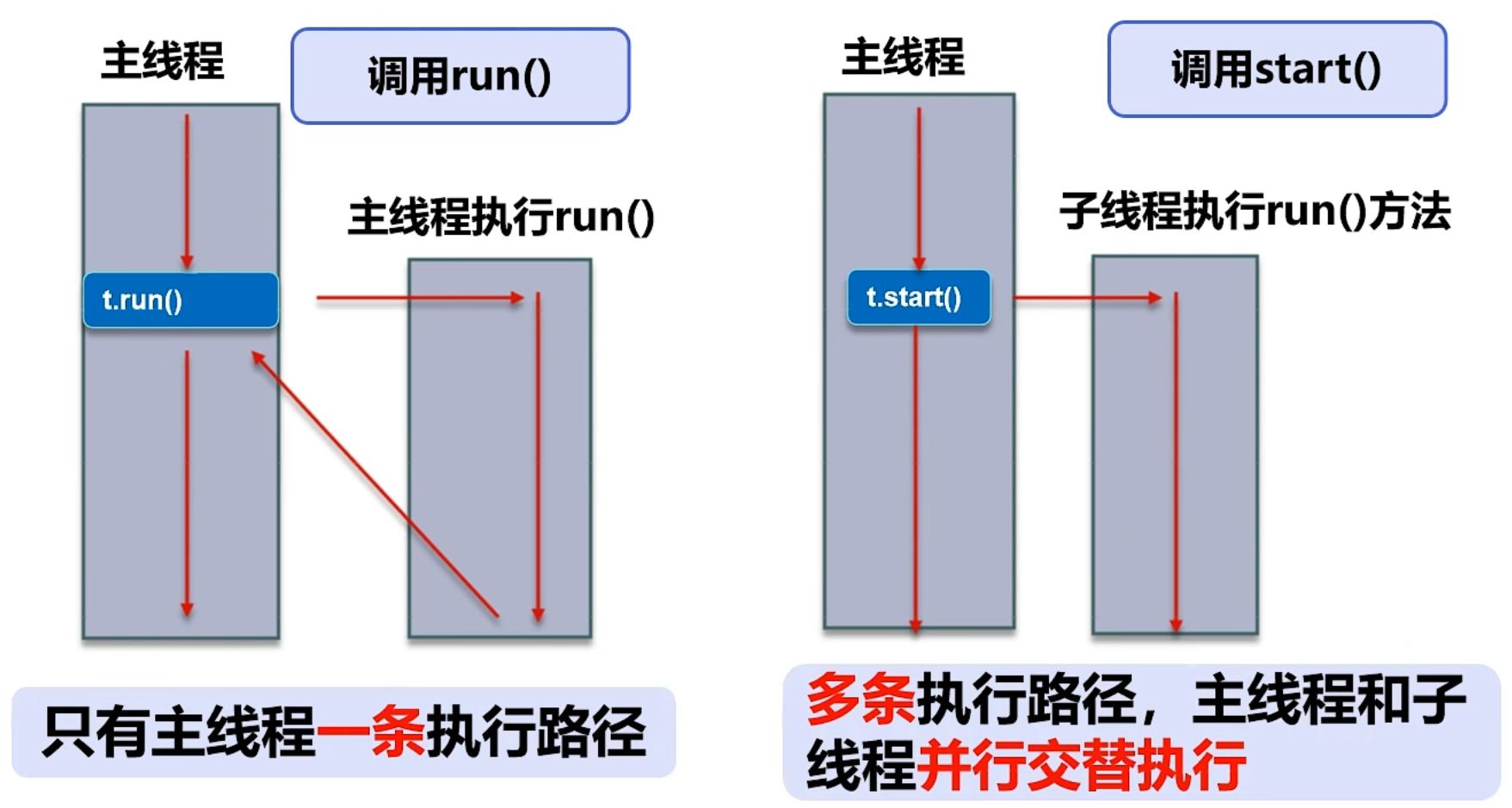
普通的程序中,方法的调用是执行到方法的时候,程序跳转到方法体中进行,是按照顺序进行的,而多线程则是多任务“同时”进行,即“边吃饭边看电视”,而不是“吃完饭再看电视”,多线程是并发执行的。(并发:短时刻内交替执行,宏观上是“同时”执行的)- 程序是指令和数据的有序集合,是静态的存储;
- 进程是执行程序的一次执行过程,是动态的执行,是系统资源分配的单位;
- 一个进程可包含若干个线程,一个进程至少拥有一个线程,线程是CPU调度和执行的单位;
可以这么理解:电脑上的QQ存储在硬盘中,是一个程序,当我们运行它的时候,它就成为了一个进程,得到了系统资源分配,而它的功能比如可以同时聊天同时打电话还可以逛空间和发邮件,这些诸多功能就是线程。
注意:很多多线程其实是模拟出来的,真正的多线程是指有多个CPU,即多核,如服务器。如果是模拟出来的多线程,即在一个CPU的情况下,在同一个时间点,CPU只能执行一个代码,但因为切换的很快,就有“同时”执行的错觉,这就是并发。
- 线程是独立的执行路径;
- 在程序运行时,即使没有自己创建线程,后台也会有多个线程,如主线程,gc线程(垃圾回收);
- 主线程即 main()函数,是系统的入口,用于执行整个程序;
- 在一个进程中,如果开辟了多个线程,线程的运行由调度器安排调度,调度器是与操作系统紧密相关的,先后顺序由调度器(操作系统)就决定,无法干预;
- 对同一份资源操作时,会存在资源抢夺问题,需要加入并发控制;
- 线程会带来额外的开销,如CPU调度时间,并发控制开销;
- 每个线程在自己的工作内存交互,内存控制不当会造成数据不一致;
- 线程可以共享进程的资源,不必再单独分配,所以线程的引入提升了性能。
Java虚拟机允许应用程序同时执行多个执行线程,每个线程都有优先权
02 进程的创建
进程的创建有如下三种方式:
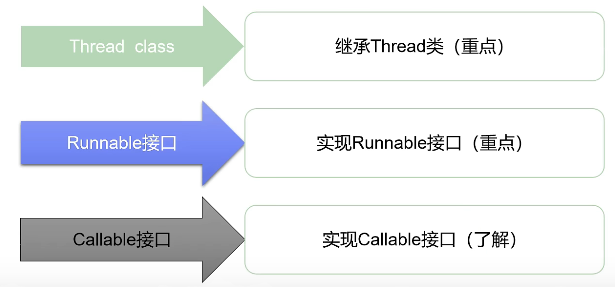
> 继承 Thread 类
-
自定义线程类继承 Thread 类;
-
重写 run( ) 方法,编写程序执行体;
-
创建线程对象,调用 start( ) 方法启动线程;
通过打印输出来判断多线程的执行顺序:
//创建线程方式一:继承Thread类,重写run()方法,调用start()方法 public class TestThread01 extends Thread{ @Override public void run() { //run方法线程体 for (int i = 0; i < 10; i++) { System.out.println("敲代码+"+i); } } public static void main(String[] args) { //main主线程 //创建一个线程对象 TestThread01 t1 = new TestThread01(); //调用start()方法开启 t1.start(); for (int i = 0; i < 1000; i++) { System.out.println("学习Java+"+i); } } }- 1
- 2
- 3
- 4
- 5
- 6
- 7
- 8
- 9
- 10
- 11
- 12
- 13
- 14
- 15
- 16
- 17
- 18
- 19
- 20
- 21
- 22
- 23
- 24
运行可知,并没有按顺序执行,而是并发执行的(由CPU调度执行):

> 实现 Runnable 接口
- 定义 MyRunnable 类实现 Runnable 接口;
- 实现 run( ) 方法,编写线程执行体;
- 创建线程对象,调用 start( ) 方法启动线程;
推荐使用 Runnable对象,因为Java单继承的局限性
//创建线程方式二:实现Runnable接口,重写run()方法,执行线程需要丢入Runnable接口实现类,调用start方法 public class TestThread02 implements Runnable{ @Override public void run() { //run方法线程体 for (int i = 0; i < 10; i++) { System.out.println("敲代码+"+i); } } public static void main(String[] args) { //创建一个Runnable接口的实现类对象 TestThread02 testThread02 = new TestThread02(); /* 创建线程对象,通过线程对象来开启线程 Thread thread = new Thread(testThread02); thread.start(); */ new Thread(testThread02).start(); for (int i = 0; i < 1000; i++) { System.out.println("学习Java+"+i); } } }- 1
- 2
- 3
- 4
- 5
- 6
- 7
- 8
- 9
- 10
- 11
- 12
- 13
- 14
- 15
- 16
- 17
- 18
- 19
- 20
- 21
- 22
- 23
- 24
- 25
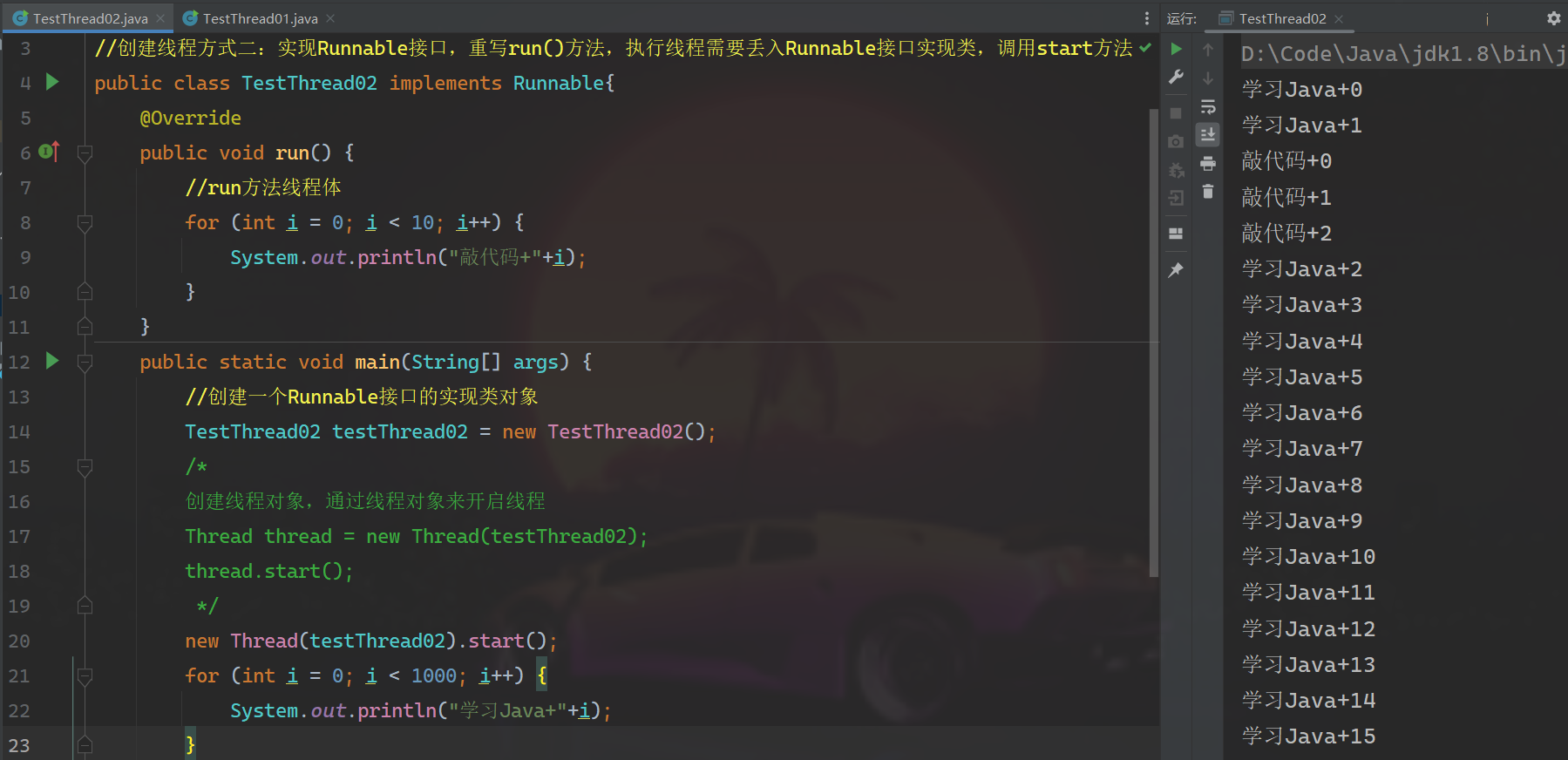
对比 继承Thread类 和 实现Runnable接口 两种方法:

继承Thread类
- 子列继承Thread类具备多线程能力;
- 启动线程:子类对象.start( );
- 不建议使用:避免OOP单继承局限性;
实现Runnable接口
- 实现Runnable具有多线程能力;
- 启动线程:传入目标对象+Thread对象.start( );
- 推荐使用:避免单继承局限性,方便同一个对象被多个线程使用;
> 实现 Callable 接口
- 实现Callable接口,需要返回值类型;
- 重写call方法,需要抛出异常;
- 创建目标对象;
- 创建执行服务:
ExecutorService ser = Executors.newFixedThreadPool(1); - 提交执行:Future result = ser.submit(thread01);
- 获取结果:boolean r1 = result.get();
- 关闭服务:ser.shutdownNow();
//进程创建方式三:实现Callable接口 public class TestCallable implements Callable<Boolean> { //重写call()方法 @Override public Boolean call() throws Exception { System.out.println("方法体"); return true; } public static void main(String[] args) throws Exception { //创建对象 TestCallable tc = new TestCallable(); //创建执行服务 ExecutorService ser = Executors.newFixedThreadPool(1); //提交执行 Future<Boolean> result = ser.submit(tc);//通过服务提交线程 //获取结果 boolean b = result.get(); //call()方法返回类型 //关闭服务 ser.shutdown(); } }- 1
- 2
- 3
- 4
- 5
- 6
- 7
- 8
- 9
- 10
- 11
- 12
- 13
- 14
- 15
- 16
- 17
- 18
- 19
- 20
- 21
- 22
- 23
- 24
- 25
- 26
Callable的好处:
- 可以定义返回值;
- 可以抛出异常;
※ Lambda表达式 λ
-
Lambda表达式是一种特殊的表达语法,能够把一段代码像数据一样作为参数传递。> Lambda详解
-
能够避免内部类定义过多;
-
简化程序定义,只留下核心的逻辑,但会降低可读性;
语法:
(params) -> expression[表达式] (params) -> statement[语句] (params) -> {statements}- 1
- 2
- 3
函数式接口的定义: 任何接口,如果只包含唯一一个抽象方法,那么它就是一个函数式接口; public interface Runnable{ public abstract void run(); } 对于函数式接口,可以通过Lambda表达式来创建该接口的对象- 1
- 2
- 3
- 4
- 5
- 6
常规定义:
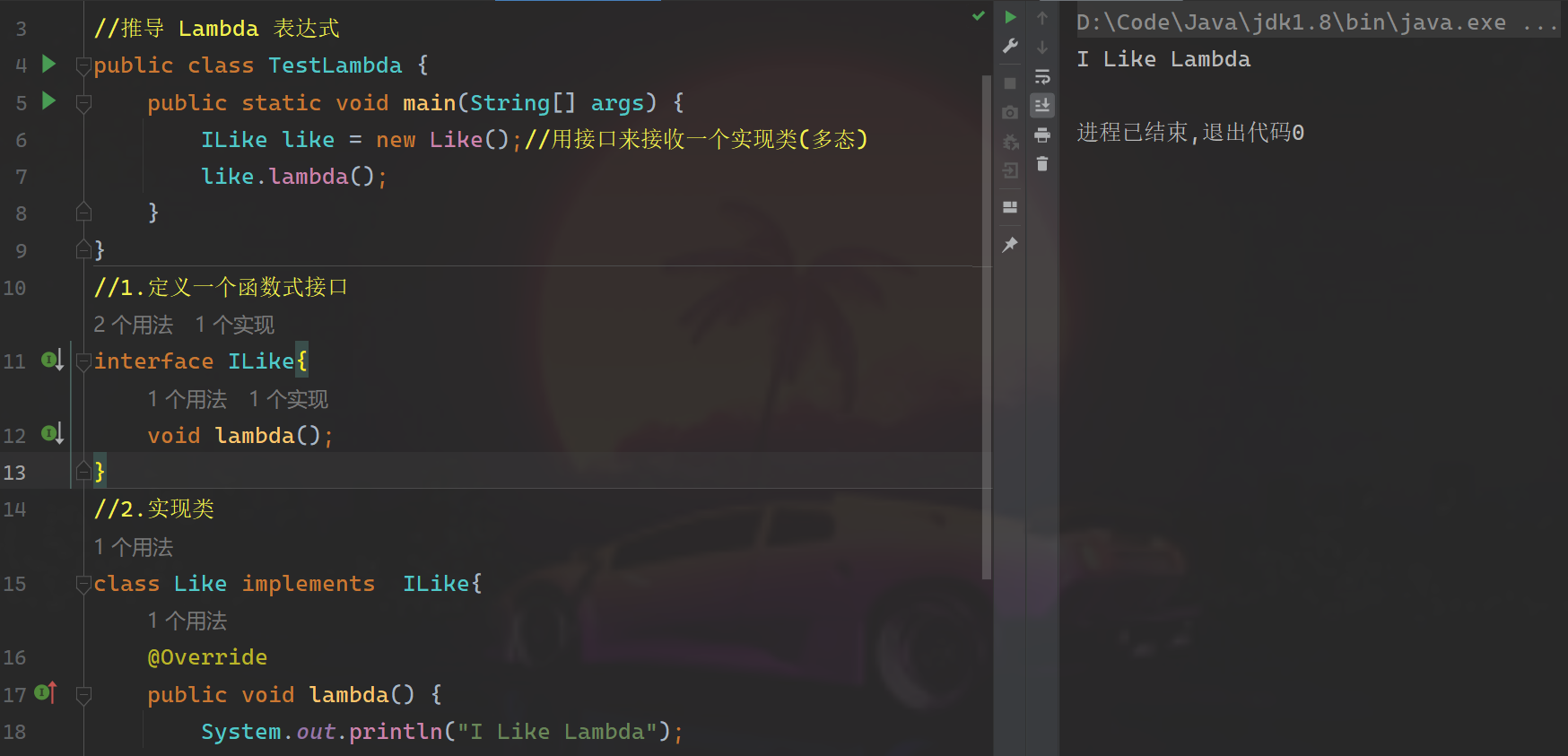
也可以使用 静态内部类(在类里面定义) :

还可以 局部内部类 (定义在方法里)和 匿名内部类(没有类名):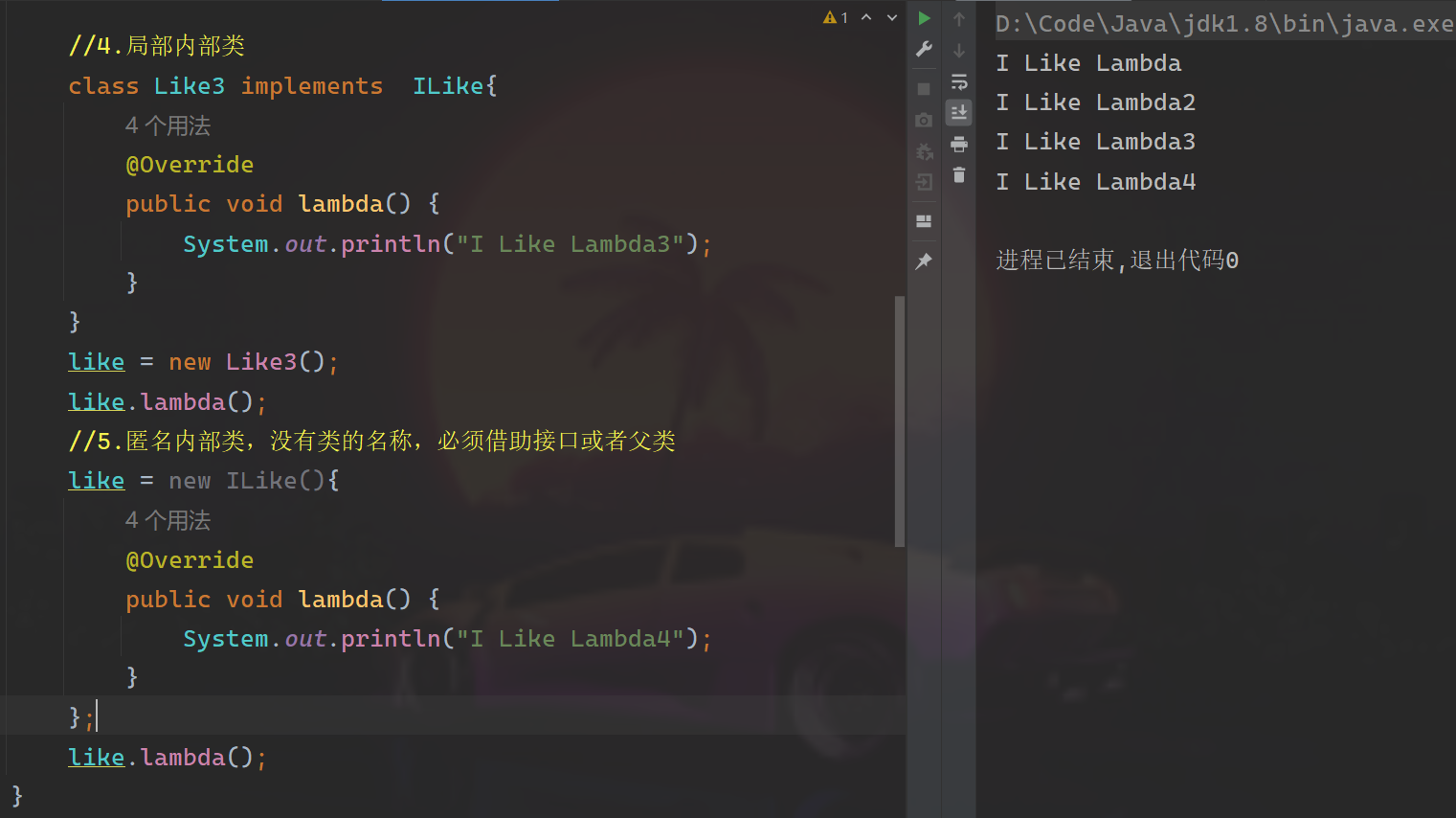
终极大招: Lambda简化
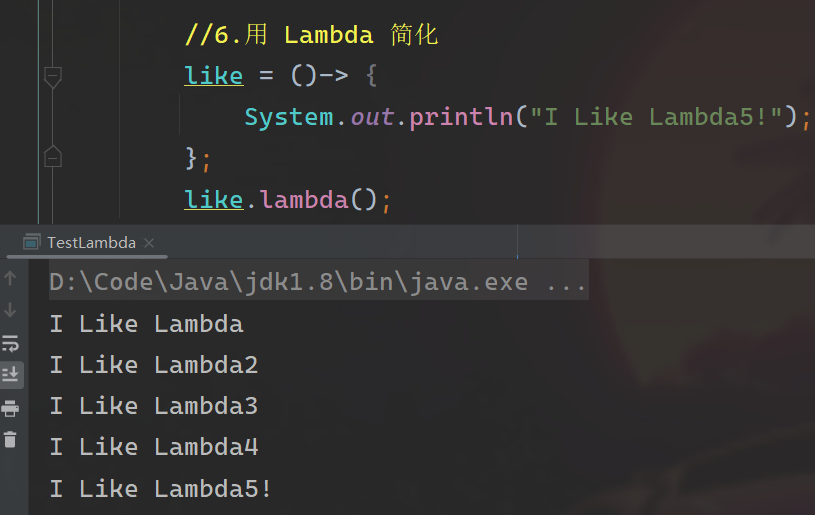
继续深入理解 Lambda 表达式:
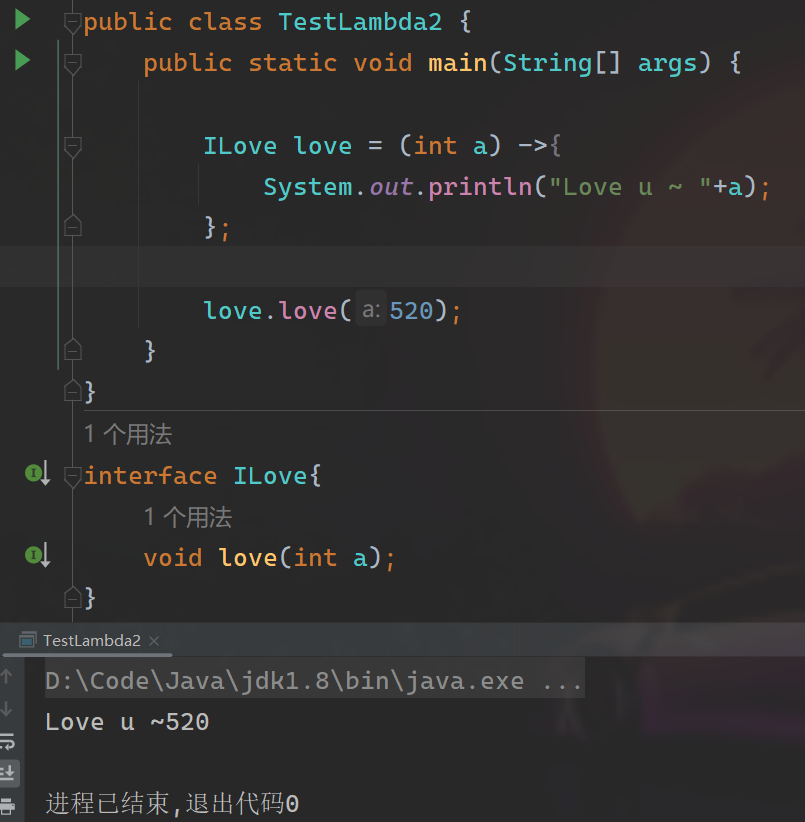
简化:
前提是接口为函数式接口;
多个参数也可以去掉参数类型;
Lambda表达式只有在一行代码的情况下才能简化没有花括号;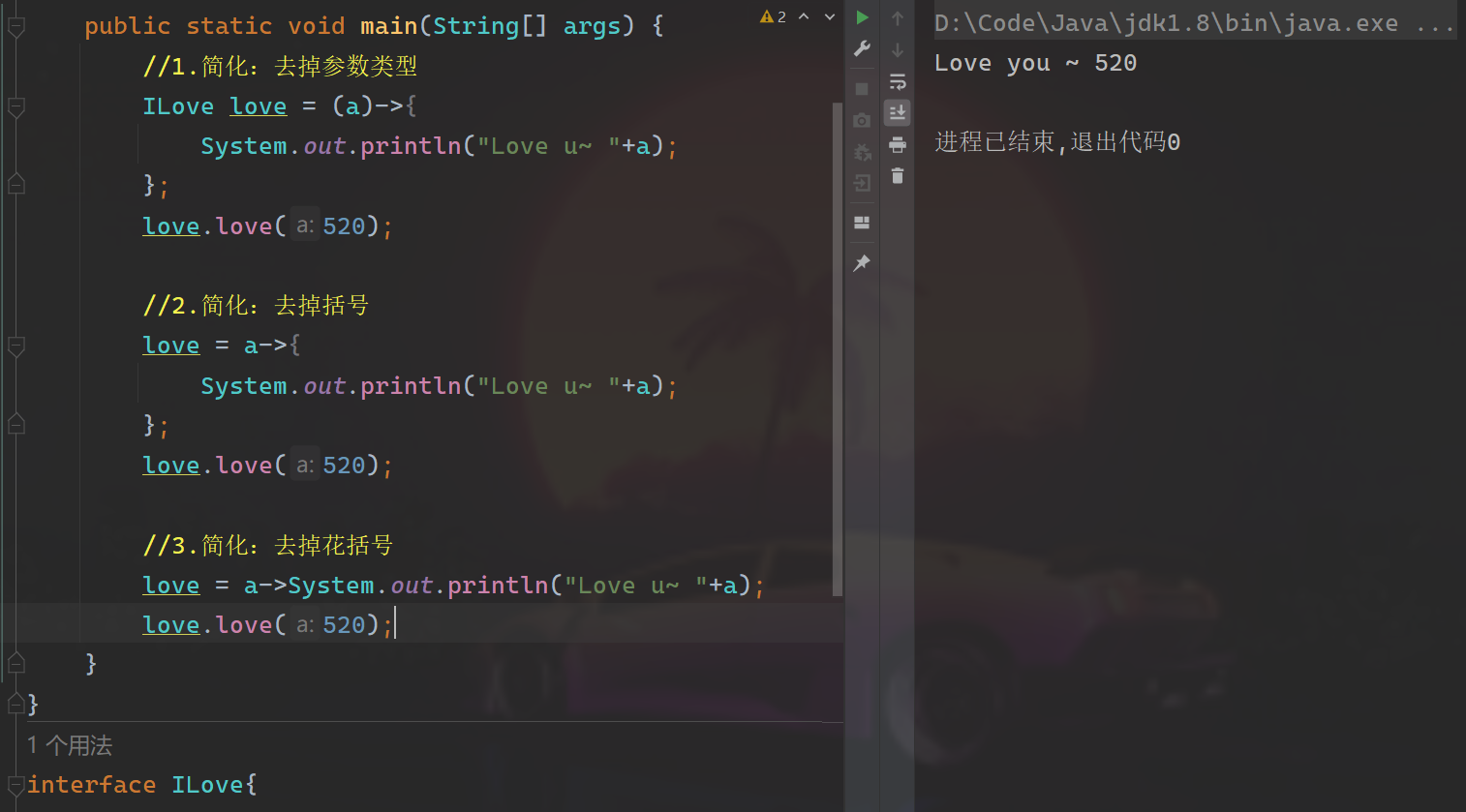
相当于:
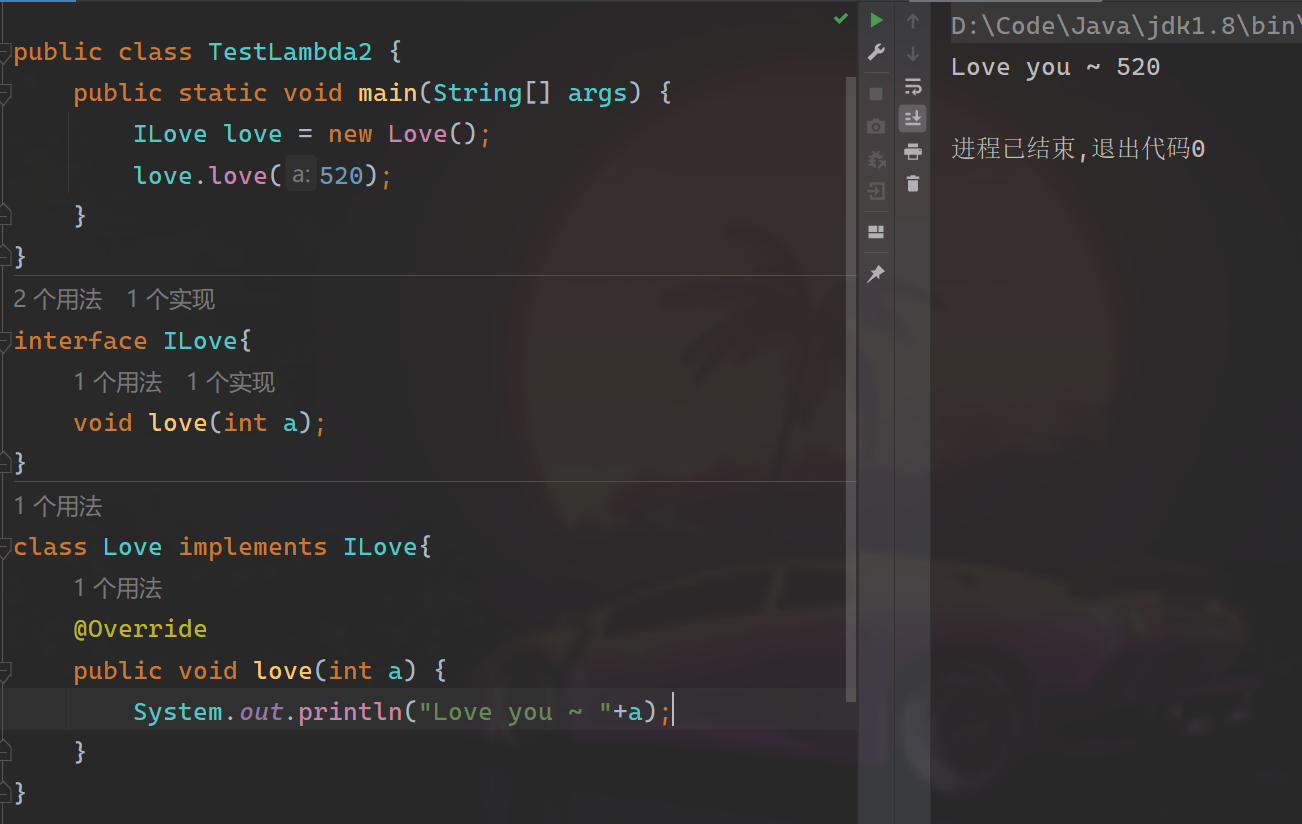
※ 静态代理模式
- 先定义一个接口;
- 真实对象和代理对象都要实现同一个接口;
- 代理对象要代理真实对象
- (就是将真实对象作为参数传入代理对象的构造方法)
- 代理对象可以做很多真实对象做不了的事;
- 真实对象可以专注做自己的事;
定义一个宠物类为真实对象,而主人类是代理对象,用主人类代理宠物类的方法:
public class StaticProxy { public static void main(String[] args) { Master master = new Master(new Pet()); master.play(); } } interface Happy{ //接口定义一个“玩”方法 void play(); } //真实角色 宠物 class Pet implements Happy{ @Override public void play() { System.out.println("拼命拼命耍"); } } //代理角色 宠物的主人 class Master implements Happy{ //代理谁(代理的真实角色) private Happy who; public Master(Happy who){ this.who = who;//真实对象 } private void before() { System.out.println("带狗出门"); } private void after() { System.out.println("回家给狗洗澡"); } @Override public void play() { before(); this.who.play(); after(); } } /* 输出: 带狗出门 拼命拼命耍 回家给狗洗澡 /*- 1
- 2
- 3
- 4
- 5
- 6
- 7
- 8
- 9
- 10
- 11
- 12
- 13
- 14
- 15
- 16
- 17
- 18
- 19
- 20
- 21
- 22
- 23
- 24
- 25
- 26
- 27
- 28
- 29
- 30
- 31
- 32
- 33
- 34
- 35
- 36
- 37
- 38
- 39
- 40
- 41
- 42
- 43
- 44
- 45
- 46
- 47
对于 多线程 的应用:
//创建一个Thread 静态代理Runnable接口 new Thread(new Runnable() { @Override public void run() { System.out.println("今天去哪里玩了呀") } }).start(); 等同于如下:(使用lambda表达式) //使用lambda表达式 new Thread(()-> System.out.println("今天去哪里玩了呀")).start(); 1.Thread是代理角色; 2.Runnable接口是真实角色; 3.Thread也实现Runnable接口; 3.所以Thread代理Runnable接口实现方法start(); new Thread(()-> System.out.println("今天去哪里玩了呀")).start(); 相当于: new Master(new Pet()).play(); Thread 和 Master 都是代理对象 Runnable 和 Pet 是真实对象- 1
- 2
- 3
- 4
- 5
- 6
- 7
- 8
- 9
- 10
- 11
- 12
- 13
- 14
- 15
- 16
- 17
- 18
- 19
- 20
- 21
- 22
- 23
- 24
- 25
03 线程状态

线程有五大状态:
- 创建状态 :new
- 就绪状态 :start( )
- 阻塞状态:sleep( ) wait( ) lock( ) synchronized( )
- 运行状态:CPU调度执行
- 死亡状态:线程终止
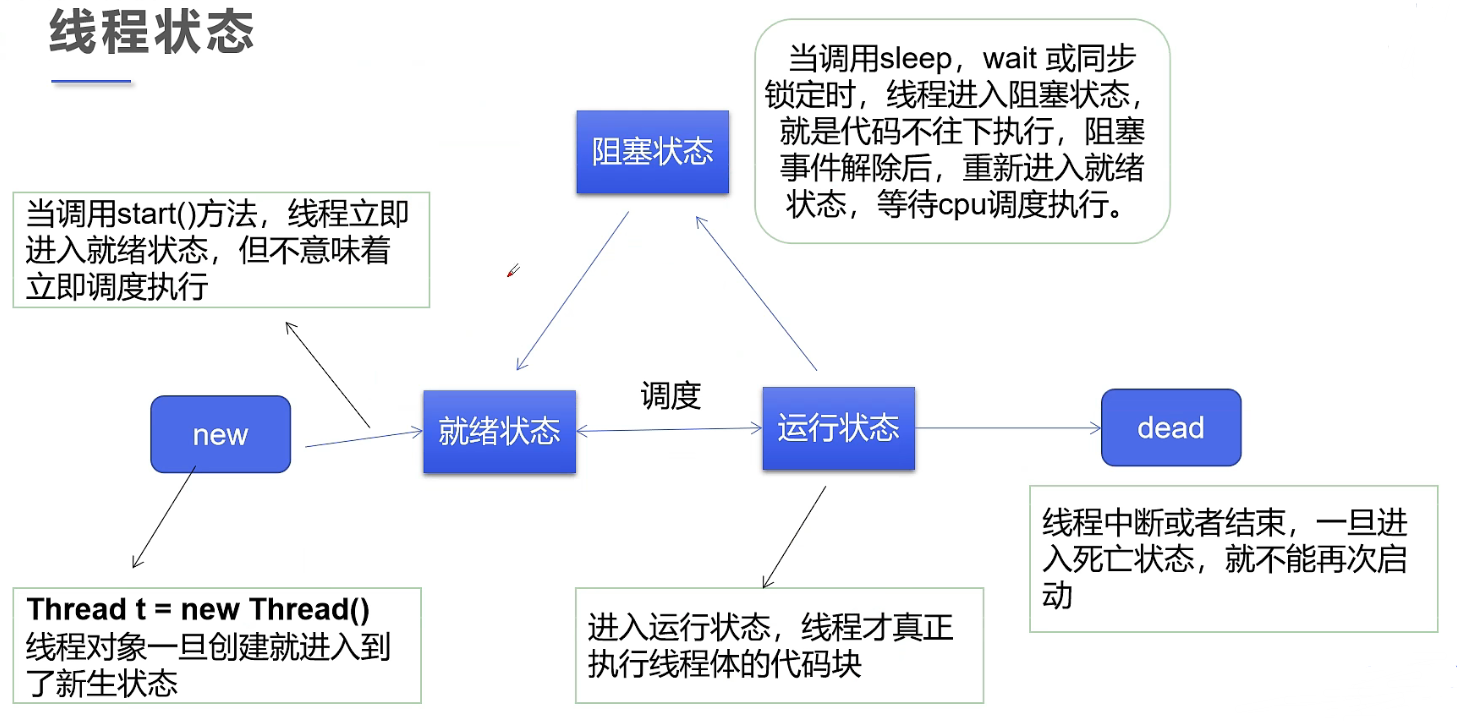
04 线程方法

> 停止线程 stop( )
- 不建议使用JDK提供的 stop( )、destroy( ) 【已废弃】;
- 建议 让线程自己停下来;
- 即:使用一个标志位进行终止变量,当 flag=false ,则终止线程运行;
- 建议线程正常停止,利用次数,不建议死循环;
- 建议使用标志位 flag 判断;
- 不要使用 stop( )或者 destroy( ) 等过时JDK不建议使用的方法;
public class TestStop implements Runnable{ //1.设置一个标识位 private boolean flag = true; @Override public void run() { int i = 0; while(flag){ System.out.println("run...Thread "+i++); } } //2.设置一个公开的方法停止线程,转换标志位 public void stop(){ //自定义的停止方法 this.flag = false; } public static void main(String[] args) { //创建Runnable实现类对象,通过线程对象开启线程 TestStop testStop = new TestStop(); new Thread(testStop).start(); for (int i = 0; i < 1000; i++) { System.out.println("main线程 "+i); if (i==900){ //调用stop方法切换标志位,让线程停止 testStop.stop(); System.out.println("线程停止"); } } } }- 1
- 2
- 3
- 4
- 5
- 6
- 7
- 8
- 9
- 10
- 11
- 12
- 13
- 14
- 15
- 16
- 17
- 18
- 19
- 20
- 21
- 22
- 23
- 24
- 25
- 26
- 27
- 28
- 29
- 30
- 31
- 32
> 线程休眠 sleep( )
- sleep( ) 指定当前线程阻塞的毫秒数;sleep(毫秒数)
- sleep存在异常 InterruptedException;
- sleep时间达到后,线程进入就绪状态;
- sleep可以模拟网络延时,倒计时等;
- 每个对象都有一个锁,sleep不会释放锁;
1 秒 = 1000 毫秒
倒计时 10、9、8 … 2、1 :
public class TestSleep implements Runnable { @Override public void run() { for (int i = 10; i > 0; i--) { System.out.println(i); try { Thread.sleep(1000); } catch (InterruptedException e) { throw new RuntimeException(e); } } } public static void main(String[] args) { TestSleep testSleep = new TestSleep(); new Thread(testSleep).start(); } }- 1
- 2
- 3
- 4
- 5
- 6
- 7
- 8
- 9
- 10
- 11
- 12
- 13
- 14
- 15
- 16
- 17
> 线程礼让 yield( )
- 礼让线程,让当前正在执行的线程暂停,但不阻塞;
- 将线程从 运行状态 为 就绪状态 ;
- 让CPU重新调度,礼让不一定成功,看CPU心情;
//测试礼让线程 //礼让不一定成功,看CPU心情 public class TestYield { public static void main(String[] args) { MyYield myYield = new MyYield(); new Thread(myYield,"a").start(); new Thread(myYield,"b").start(); } } class MyYield implements Runnable{ @Override public void run(){ System.out.println(Thread.currentThread().getName()+"线程开始执行"); Thread.yield(); System.out.println(Thread.currentThread().getName()+"线程停止执行"); } }- 1
- 2
- 3
- 4
- 5
- 6
- 7
- 8
- 9
- 10
- 11
- 12
- 13
- 14
- 15
- 16
- 17
- 18
运行结果如下(多种):



> 线程强行执行 join( )
- Join 合并线程,待此线程执行完成后,再执行其他线程,其他线程阻塞;
- 可以理解为 “ 插队 ”
//测试join方法 相当于“插队” public class TestJoin implements Runnable{ @Override public void run() { for (int i = 0; i < 1000; i++) { System.out.println("线程 BOSS 来啦"+i); } } public static void main(String[] args) throws InterruptedException { //启动线程 TestJoin testJoin = new TestJoin(); Thread thread = new Thread(testJoin); thread.start(); //主线程 for (int i = 0; i < 500; i++) { if(i==200){ thread.join();//线程插队 } System.out.println("main "+i); } } } //如果子线程会穿插在主线程中,可以在run()中加个sleep() /* main 0 main 1 ... main 198 main 199 线程 BOSS 来啦0 线程 BOSS 来啦1 线程 BOSS 来啦2 ... 线程 BOSS 来啦998 线程 BOSS 来啦999 main 200 main 201 ... main 498 main 499 */- 1
- 2
- 3
- 4
- 5
- 6
- 7
- 8
- 9
- 10
- 11
- 12
- 13
- 14
- 15
- 16
- 17
- 18
- 19
- 20
- 21
- 22
- 23
- 24
- 25
- 26
- 27
- 28
- 29
- 30
- 31
- 32
- 33
- 34
- 35
- 36
- 37
- 38
- 39
- 40
- 41
- 42
> 线程状态观测 Thread.State
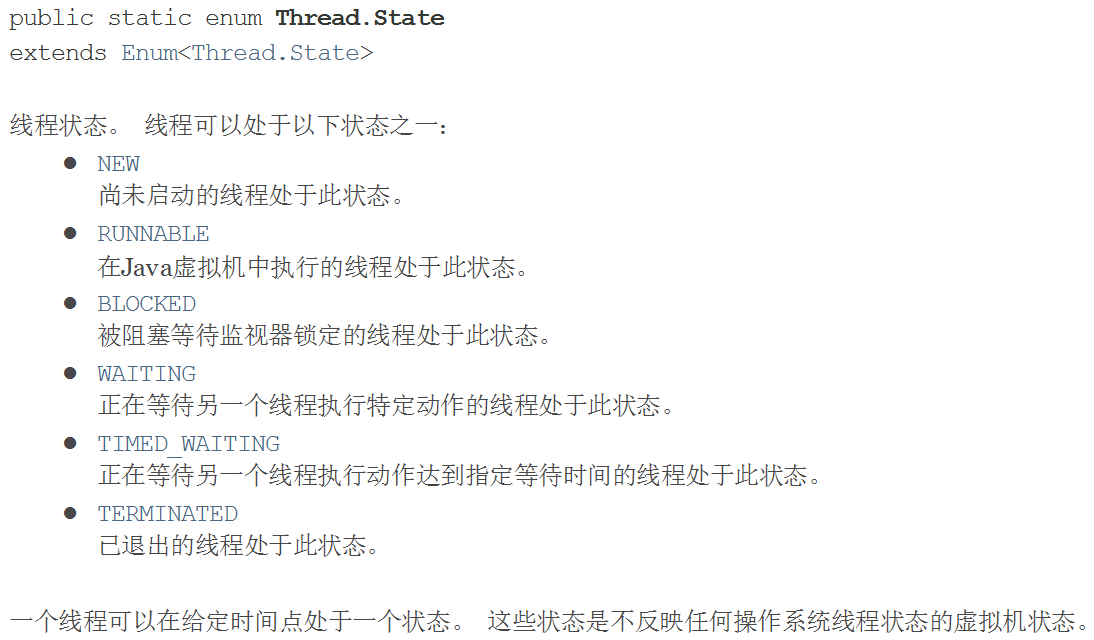
//观察线程状态 public class TestState { public static void main(String[] args) throws InterruptedException { Thread thread = new Thread(()->{ //Lambda表达式 for (int i = 0; i < 5; i++) { try { Thread.sleep(1000); } catch (InterruptedException e) { throw new RuntimeException(e); } } System.out.println("-------------"); }); //观察状态 Thread.State state = thread.getState(); //观察启动后 thread.start(); state = thread.getState(); System.out.println(state);//Run //只要线程不终止,就一直输出状态 while(state!=Thread.State.TERMINATED){ Thread.sleep(100); state = thread.getState();//更新线程状态 System.out.println(state);//输出状态 } thread.start(); } } /* 输出: RUNNABLE TIMED_WAITING TIMED_WAITING ...... TIMED_WAITING ------------- TERMINATED */- 1
- 2
- 3
- 4
- 5
- 6
- 7
- 8
- 9
- 10
- 11
- 12
- 13
- 14
- 15
- 16
- 17
- 18
- 19
- 20
- 21
- 22
- 23
- 24
- 25
- 26
- 27
- 28
- 29
- 30
- 31
- 32
- 33
- 34
- 35
- 36
- 37
- 38
- 39
- 40
> 线程的优先级 Priority
- Java提供一个线程调度器来监控程序中启动后进入就绪状态的所有线程,线程调度器按照优先级决定应该调度哪个线程来执行;
- 线程的优先级用数字表示,范围从 1 ~ 10 .
- Thread.MIN_PRIORITY = 1 ;
- Thread.MAX_PRIORITY = 10 ;
- Thread.NORM_PRIORITY = 5 ;
- 使用以下方法改变或获取优先级:
- getPriority( ) 、 setPriority( int x)
//测试线程的优先级 public class TestPriority { public static void main(String[] args ){ //主线程默认优先级 System.out.println(Thread.currentThread().getName()+"--->Priority "+ Thread.currentThread().getPriority()); MyPriority myPriority = new MyPriority(); Thread t1 = new Thread(myPriority); Thread t2 = new Thread(myPriority); Thread t3 = new Thread(myPriority); Thread t4 = new Thread(myPriority); //先设置优先级,再启动 t1.start(); t2.setPriority(1); t2.start(); t3.setPriority(4); t3.start(); t4.setPriority(Thread.MAX_PRIORITY);//MAX_PRIORITY=10 t4.start(); } } class MyPriority implements Runnable{ @Override public void run() { System.out.println(Thread.currentThread().getName()+ "--->Priority "+Thread.currentThread().getPriority()); } } /* main--->Priority 5 Thread-0--->Priority 5 Thread-3--->Priority 10 Thread-2--->Priority 4 Thread-1--->Priority 1 进程已结束,退出代码0 */- 1
- 2
- 3
- 4
- 5
- 6
- 7
- 8
- 9
- 10
- 11
- 12
- 13
- 14
- 15
- 16
- 17
- 18
- 19
- 20
- 21
- 22
- 23
- 24
- 25
- 26
- 27
- 28
- 29
- 30
- 31
- 32
- 33
- 34
- 35
- 36
- 37
- 38
- 39
- 40
- 41
优先级低只是意味着获得调度的概率低,并不是优先级低就不会被调用,都是看CPU的调度
> 守护多线程 daemon
- 线程分为 用户线程 和 守护线程 ;
- 虚拟机必须确保用户线程执行完毕;
- 虚拟机不用等待守护线程执行完毕;
- 如:后台记录操作日志,监控内存,垃圾回收…等等;
守护线程是程序运行的时候在后台提供一种通用服务的线程。
所有用户线程停止,进程才会停掉所有守护线程,退出程序。//测试守护线程 //上帝守护你 public class TestDaemon { public static void main(String[] args) { God god = new God(); You you = new You(); Thread thread = new Thread(god); thread.setDaemon(true);//默认是false表示是用户线程,正常的线程都是用户线程 thread.start(); new Thread(you).start();//你 用户线程启动 } } //上帝 class God implements Runnable{ @Override public void run(){ while(true){ System.out.println("上帝保佑你"); } } } //你 class You implements Runnable{ @Override public void run(){ for (int i = 0; i < 36500; i++) { System.out.println("开心快乐的活着"); } System.out.println("--> goodbye world <--"); } } //可以自己运行一下,很有意思- 1
- 2
- 3
- 4
- 5
- 6
- 7
- 8
- 9
- 10
- 11
- 12
- 13
- 14
- 15
- 16
- 17
- 18
- 19
- 20
- 21
- 22
- 23
- 24
- 25
- 26
- 27
- 28
- 29
- 30
- 31
- 32
- 33
05 线程同步机制
- 多个线程操作同一个资源 ,例如:
- 上万人同时抢100张票;
- 两个银行同时取钱
现实生活中,会遇到“同一个资源,多个人都想使用”的问题,例如:食堂排队打饭,每个人都想吃饭,最简单的解决办法就是,排队,一个一个来。
处理多线程时,多个线程访问同一个对象,并且某些线程还想修改这个对象,这时候需要线程同步;线程同步其实就是一种 等待机制,多个需要同时访问此对象的线程进入到这个 对象的等待池 形成队列,等待前面线程使用完毕,下一个线程再使用。
这个时候需要两种东西: 队列 和 锁 ;
> 线程同步
由于同一个进程的多个线程共享同一个存储空间,在带来方便的同时,也带来了访问冲突问题,为了保证数据在方法中被访问时的正确性,在访问时加入 锁机制 synchronized ,当一个线程获得对象的排它锁,独占资源,其他线程必须等待,使用后释放锁即可,存在以下问题:
- 一个线程持有锁会导致其他所有需要此锁的线程挂起;
- 在多线程竞争下,加锁,释放锁会导致比较多的上下文切换和调度延时,引起性能问题;
- 如果一个优先级高的线程等待一个优先级低的线程释放锁,会导致优先级倒置,引起性能问题;
※ 不安全案例
01 不安全的买票
线程不同步,可能会出现拿到 -1张票的情况
//不安全的买票 //线程不安全,会出现负数 public class UnsafeBuyTicket { public static void main(String[] args){ BuyTicket station = new BuyTicket(); new Thread(station,"你").start(); new Thread(station,"我").start(); new Thread(station,"他").start(); } } class BuyTicket implements Runnable{ //票 private int ticketNums = 10; boolean flag = true;//外部停止方式 @Override public void run(){ while(flag){ try { buy(); } catch (InterruptedException e) { throw new RuntimeException(e); } } } private void buy() throws InterruptedException { //判断是否有票 if(ticketNums <=0){ flag = false; return; } //模拟延时 Thread.sleep(100); //买票 System.out.println(Thread.currentThread().getName()+"拿到"+ticketNums--); } }- 1
- 2
- 3
- 4
- 5
- 6
- 7
- 8
- 9
- 10
- 11
- 12
- 13
- 14
- 15
- 16
- 17
- 18
- 19
- 20
- 21
- 22
- 23
- 24
- 25
- 26
- 27
- 28
- 29
- 30
- 31
- 32
- 33
- 34
- 35
- 36
- 37
02 不安全的银行
多个线程同时对银行发起取钱,会导致出现取多了的情况
//不安全的取钱 //两个人去银行取钱,账户 public class UnsafeBank { public static void main(String[] args) { //账户 Account account = new Account(100,"基金"); Drawing you = new Drawing(account,50,"你"); Drawing me = new Drawing(account,100,"我"); you.start(); me.start(); } } //账户 class Account { int money;//余额 String name;//卡名 public Account(int money,String name){ this.money = money; this.name = name; } } //银行:模拟取款 class Drawing extends Thread{ Account account;//账户 //取了多少钱 int drawingMoney; //现在手里有多少钱 int nowMoney; public Drawing(Account account,int drawingMoney,String name){ super(name); this.account = account; this.drawingMoney = drawingMoney; } //取钱 @Override public void run(){ //判断有没有钱 if(account.money-drawingMoney<0){ System.out.println(Thread.currentThread().getName()+"钱不够,取不了"); return; } try { Thread.sleep(1000); } catch (InterruptedException e) { throw new RuntimeException(e); } //卡内余额 = 余额 - 取走的钱 account.money = account.money - drawingMoney; //手里的钱 nowMoney = nowMoney+ drawingMoney; System.out.println(account.name+"余额为"+account.money); //Thread.currentThread().getName() = this.getName; System.out.println(this.getName()+"手里的钱"+nowMoney); } } /* 基金余额为-50 你手里的钱50 基金余额为-50 我手里的钱100 进程已结束,退出代码0 */- 1
- 2
- 3
- 4
- 5
- 6
- 7
- 8
- 9
- 10
- 11
- 12
- 13
- 14
- 15
- 16
- 17
- 18
- 19
- 20
- 21
- 22
- 23
- 24
- 25
- 26
- 27
- 28
- 29
- 30
- 31
- 32
- 33
- 34
- 35
- 36
- 37
- 38
- 39
- 40
- 41
- 42
- 43
- 44
- 45
- 46
- 47
- 48
- 49
- 50
- 51
- 52
- 53
- 54
- 55
- 56
- 57
- 58
- 59
- 60
- 61
- 62
- 63
- 64
03 线程不安全的集合
//线程不安全的集合 public class UnsafeList { public static void main(String[] args) throws InterruptedException { List<String> list = new ArrayList<String>(); for (int i = 0; i < 10000; i++) { new Thread(()->{ list.add(Thread.currentThread().getName()); }).start(); } System.out.println(list.size()); } } /* 9997 进程已结束,退出代码0 */- 1
- 2
- 3
- 4
- 5
- 6
- 7
- 8
- 9
- 10
- 11
- 12
- 13
- 14
- 15
> 同步方法及方法块
由于可以通过 private 关键字可以保证数据对象只能被方法访问,所以只需针对方法提出一套机制,这套机制就是 synchronized 关键字,它包括两种用法:
- synchronized 方法 和 synchronized 块
同步方法:
public synchronized void method( int args){}- 1
synchronized 方法控制对 “对象” 的访问,每个对象对应一把锁,每个 synchronized 方法都必须获得调用该方法的对象的锁才能执行,否则线程会阻塞,方法一旦执行,就独占该锁,直到该方法返回才释放锁,后面被阻塞的线程才能获得这个锁,继续执行。
-
缺陷:若将一个大的方法声明为 synchronized 将会影响效率
-
弊端:方法里面需要修改的内容才需要锁,锁的太多,浪费资源,这个时候就需要 同步块 来解决
同步块:
- 同步块: synchronized ( Obj ) { }
- Obj 称之为同步监视器
- Obj可以为任何对象,推荐使用共享资源作为同步监视器;
- 同步方法中无需指定同步监视器,因为同步方法的同步监视器就是 this 这个对象本身,或者是 class;
- 同步监视器的执行过程:
- 第一个线程访问,锁定同步监视器,执行其中代码;
- 第二个线程访问,发现同步监视器被锁定,无法访问;
- 第一个线程访问完毕,解锁同步监视器;
- 第二个线程访问,发现同步监视器没有锁,然后锁定并访问;
解决之前不安全的买票:(同步方法)
//安全的买票 public class UnsafeBuyTicket { public static void main(String[] args){ BuyTicket station = new BuyTicket(); new Thread(station,"你").start(); new Thread(station,"我").start(); new Thread(station,"他").start(); } } class BuyTicket implements Runnable{ //票 private int ticketNums = 10; boolean flag = true;//外部停止方式 @Override public void run(){ while(flag){ try { buy(); } catch (InterruptedException e) { throw new RuntimeException(e); } } } //synchronized 定义为同步方法,锁的是 this private synchronized void buy() throws InterruptedException { //判断是否有票 if(ticketNums <=0){ flag = false; return; } //模拟延时 Thread.sleep(100); //买票 System.out.println(Thread.currentThread().getName()+"拿到"+ticketNums--); } }- 1
- 2
- 3
- 4
- 5
- 6
- 7
- 8
- 9
- 10
- 11
- 12
- 13
- 14
- 15
- 16
- 17
- 18
- 19
- 20
- 21
- 22
- 23
- 24
- 25
- 26
- 27
- 28
- 29
- 30
- 31
- 32
- 33
- 34
- 35
- 36
- 37
- 38
- 39
- 40
解决不安全的银行:(同步块)
//安全的取钱 //两个人去银行取钱,账户 public class UnsafeBank { public static void main(String[] args) { //账户 Account account = new Account(100,"基金"); Drawing you = new Drawing(account,50,"你"); Drawing me = new Drawing(account,100,"我"); you.start(); me.start(); } } //账户 class Account { int money;//余额 String name;//卡名 public Account(int money,String name){ this.money = money; this.name = name; } } //银行:模拟取款 class Drawing extends Thread{ Account account;//账户 //取了多少钱 int drawingMoney; //现在手里有多少钱 int nowMoney; public Drawing(Account account,int drawingMoney,String name){ super(name); this.account = account; this.drawingMoney = drawingMoney; } //取钱 @Override public void run(){ //全部放到同步块中 监视account synchronized(account) { //判断有没有钱 if(account.money-drawingMoney<0){ System.out.println(Thread.currentThread().getName()+"钱不够,取不了"); return; } try { Thread.sleep(1000); } catch (InterruptedException e) { throw new RuntimeException(e); } //卡内余额 = 余额 - 取走的钱 account.money = account.money - drawingMoney; //手里的钱 nowMoney = nowMoney+ drawingMoney; System.out.println(account.name+"余额为"+account.money); //Thread.currentThread().getName() = this.getName; System.out.println(this.getName()+"手里的钱"+nowMoney); } } }/* 基金余额为50 你手里的钱50 我钱不够,取不了 进程已结束,退出代码0 */- 1
- 2
- 3
- 4
- 5
- 6
- 7
- 8
- 9
- 10
- 11
- 12
- 13
- 14
- 15
- 16
- 17
- 18
- 19
- 20
- 21
- 22
- 23
- 24
- 25
- 26
- 27
- 28
- 29
- 30
- 31
- 32
- 33
- 34
- 35
- 36
- 37
- 38
- 39
- 40
- 41
- 42
- 43
- 44
- 45
- 46
- 47
- 48
- 49
- 50
- 51
- 52
- 53
- 54
- 55
- 56
- 57
- 58
- 59
- 60
- 61
- 62
- 63
- 64
- 65
- 66
- 67
- 68
- 69
- 70
- 71
- 72
- 73
- 74
解决不安全的集合:(同步块)
//线程安全的集合 public class UnsafeList { public static void main(String[] args) throws InterruptedException { List<String> list = new ArrayList<String>(); for (int i = 0; i < 10000; i++) { new Thread(()->{ synchronized (list){ list.add(Thread.currentThread().getName()); } }).start(); } Thread.sleep(3000); System.out.println(list.size()); } } /* 10000 进程已结束,退出代码0 */- 1
- 2
- 3
- 4
- 5
- 6
- 7
- 8
- 9
- 10
- 11
- 12
- 13
- 14
- 15
- 16
- 17
- 18
※ 安全类型的集合 CopyOnWriteArrayList
import java.util.concurrent.CopyOnWriteArrayList; //测试JUC安全类型的集合 CopyOnWriteArrayList public class UnsafeList { public static void main(String[] args) throws InterruptedException { CopyOnWriteArrayList<String> list = new CopyOnWriteArrayList<String>(); for (int i = 0; i < 10000; i++) { new Thread(()->{ list.add(Thread.currentThread().getName()); }).start(); } Thread.sleep(3000); System.out.println(list.size()); } } /* 10000 进程已结束,退出代码0 */- 1
- 2
- 3
- 4
- 5
- 6
- 7
- 8
- 9
- 10
- 11
- 12
- 13
- 14
- 15
- 16
- 17
- 18
- 19
06 死锁
什么是死锁?
多个线程各自占有一些共享资源,并且互相等待其他线程占有的资源才能运行,而导致两个或者多个线程都在等待对方释放资源,都停止执行的情形。某一个同步块同时拥有“ 两个以上对象的锁 ” 时,就可能会发生 " 死锁 " 问题。
简单来说就是,甲需要乙手中的东西,而乙又想要甲手中的东西,两者陷入死循环,这就是死锁。
例:有两个女生,一个是灰姑娘,一个是白雪公主,两人都想化妆,但一个有口红,一个有镜子,她们都互相想要对方手里的东西,陷入了僵持:这就是死锁
//死锁:多个线程互相抱着对方需要的资源,然后形成僵持 public class DeadLock { public static void main(String[] args) { Makeup girl1 = new Makeup(0,"灰姑娘"); Makeup girl2 = new Makeup(1,"白雪公主"); girl1.start(); girl2.start(); } } //口红 class LipStick{} //镜子 class Mirror{} class Makeup extends Thread{ //需要的资源只有一份,用static来保证只有一份(不然不同对象的都不同) static LipStick lipstick = new LipStick(); static Mirror mirror = new Mirror(); int choice;//选择 String name;//使用化妆品的人 Makeup(int choice,String name){ this.choice = choice; this.name = name; } @Override public void run() { //化妆 try { makeup(); } catch (InterruptedException e) { throw new RuntimeException(e); } } //化妆,互相持有对方的锁,就是需要拿到对方的资源 private void makeup() throws InterruptedException { if(choice == 0){ synchronized(lipstick) { System.out.println(this.name + "获得口红的锁"); Thread.sleep(1000); //一秒钟后获得锁 synchronized (mirror) { System.out.println(this.name+ "获得镜子的锁"); Thread.sleep(1000); } } }else{ synchronized(mirror){ System.out.println(this.name+"获得镜子的锁"); Thread.sleep(1000); //一秒钟后获得锁 synchronized(lipstick){ System.out.println(this.name+"获得口红的锁"); Thread.sleep(1000); } } } } }- 1
- 2
- 3
- 4
- 5
- 6
- 7
- 8
- 9
- 10
- 11
- 12
- 13
- 14
- 15
- 16
- 17
- 18
- 19
- 20
- 21
- 22
- 23
- 24
- 25
- 26
- 27
- 28
- 29
- 30
- 31
- 32
- 33
- 34
- 35
- 36
- 37
- 38
- 39
- 40
- 41
- 42
- 43
- 44
- 45
- 46
- 47
- 48
- 49
- 50
- 51
- 52
- 53
- 54
- 55
- 56
- 57
- 58
- 59
- 60
- 61
- 62
- 63
- 64
- 65
如何避免死锁?
产生死锁的四个必要条件:
- 互斥条件:一个资源每次只能被一个进程使用;
- 请求与保持条件:一个进程因请求资源而阻塞时,对已获得的资源保持不放;
- 不剥夺条件:进程已获得的资源,在未使用完之前,不能强行剥夺;
- 循环等待条件:若干进程之间形成一种头尾相接的循环等待资源关系;
只要破其中的任意一个或多个条件就可以避免死锁发生
Lock 锁
- 从JDK5.0开始,Java提供了更强大的线程同步机制 —— 通过显示定义同步锁对象来实现同步;同步锁使用Lock对象充当;
- java.util.concurrent.locks.Lock 接口是控制多个线程对共享资源进行访问的工具;
- 锁提供了对共享资源的独占访问,每次只能有一个线程对 Lock 对象加锁,线程开始访问共享资源之前应该先获得 Lock 对象;
- ReentrantLock 类实现了 Lock,它拥有与 synchronized 相同的并发性和内存语义,在实现线程安全的控制中,比较常见的是 ReentrantLock,可以显式加锁,释放锁;
class Test{ private final ReentrantLock lock = new ReentrantLock(); public void method(){ lock.lock(); try{ //保证线程安全的代码 }finally{ lock.unlock(); //如果同步代码有异常,要将unlock()写入finally语句块 } } }- 1
- 2
- 3
- 4
- 5
- 6
- 7
- 8
- 9
- 10
- 11
- 12
synchronized 与 Lock 的对比:
- Lock是显示锁(手动开启和关闭锁,别忘记关锁)synchronized是隐式锁,出了作用域自动释放;
- Lock只有代码块锁,synchronized有代码块锁和方法锁;
- 使用 Lock锁,JVM将花费较少的时间来调度线程,性能更好,且具有更好的扩展性(提供更多的子类);
- 优先使用顺序:
- Lock > 同步代码块(已经进入方法体,分配了相应资源) > 同步方法(在方法体之外)
先看不加锁的,运行结果发现输出结果有误:
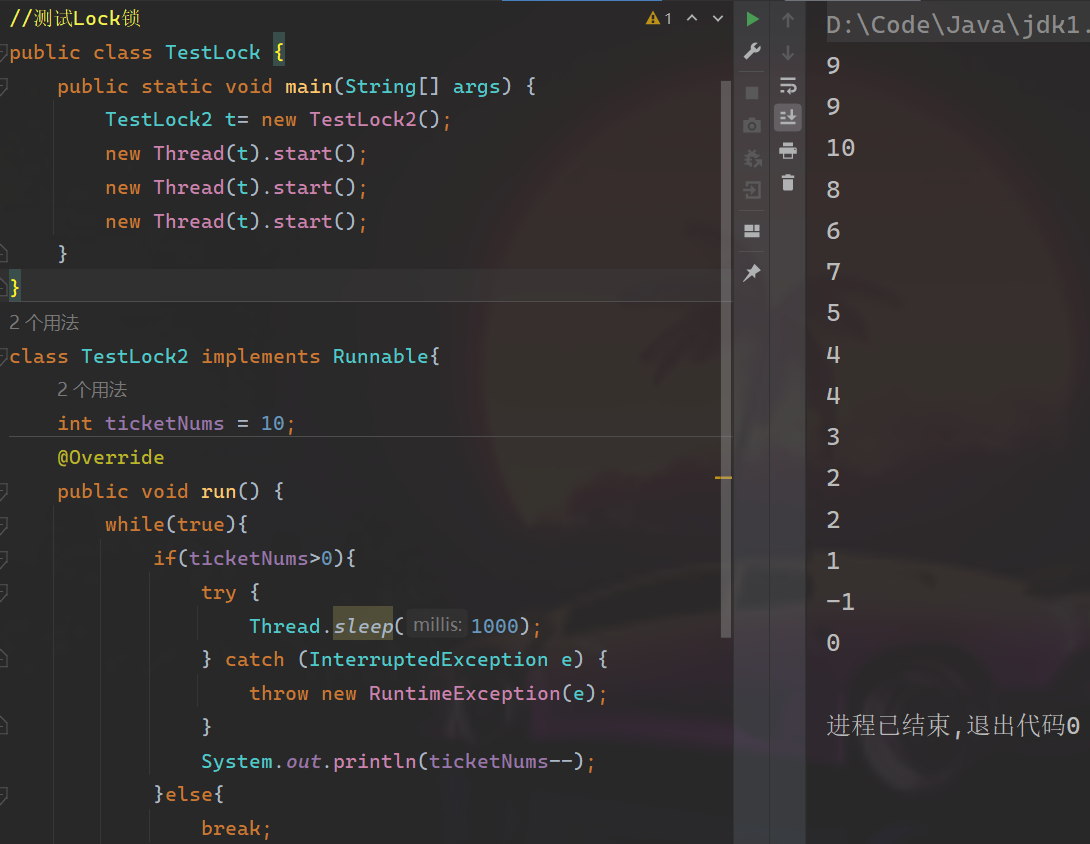
然后用 ReentrantLock 加锁解锁 解决://测试Lock锁 public class TestLock { public static void main(String[] args) { TestLock2 t= new TestLock2(); new Thread(t).start(); new Thread(t).start(); new Thread(t).start(); } } class TestLock2 implements Runnable{ int ticketNums = 10; //定义Lock锁 private final ReentrantLock lock = new ReentrantLock(); @Override public void run() { while(true){ try{ lock.lock();//加锁 if(ticketNums>0){ try { Thread.sleep(1000); } catch (InterruptedException e) { throw new RuntimeException(e); } System.out.println(ticketNums--); }else{ break; } }finally { //解锁 lock.unlock(); } } } }- 1
- 2
- 3
- 4
- 5
- 6
- 7
- 8
- 9
- 10
- 11
- 12
- 13
- 14
- 15
- 16
- 17
- 18
- 19
- 20
- 21
- 22
- 23
- 24
- 25
- 26
- 27
- 28
- 29
- 30
- 31
- 32
- 33
- 34
- 35
- 36
- 37
07 线程协作
生产者和消费者问题
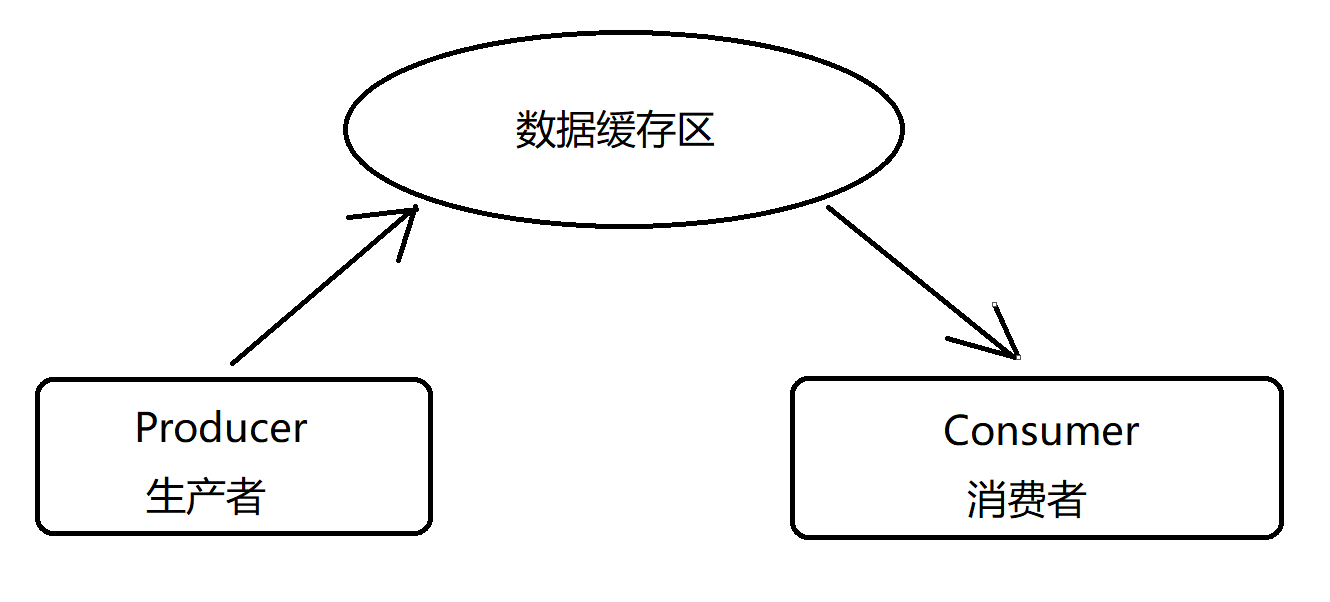
- 假设仓库中只能存放一件产品,生产者将生产出来的产品放入仓库,消费者将仓库中产品取走消费;
- 如果仓库中没有产品,则生产者将产品放入仓库,否则停止生产并等待,直到仓库中的产品被消费者取走为止;
- 如果仓库中放有产品,则消费者可以将产品取走消费,否则停止消费并等待,直到仓库中再次放入产品为止;
这是一个线程同步问题,生产者和消费者共享同一个资源,并且生产者和消费者之间相互依赖,互为条件:
- 对于生产者,没有生产产品之前,要通知生产者已经结束消费,需要生产新的品以供消费;
- 对于消费者,在消费之后,要通知生产者已经结束消费,需要生产新的产品以供消费;
- 在生产者消费者问题中,仅有 synchronized 是不够的;
- synchronized 可阻止并发更新同一个资源,实现同步;
- synchronized 不能用来实现不同线程之间的消息传递(线程通信)
> 线程通信
Java提供了几个方法解决线程之间的通信问题:
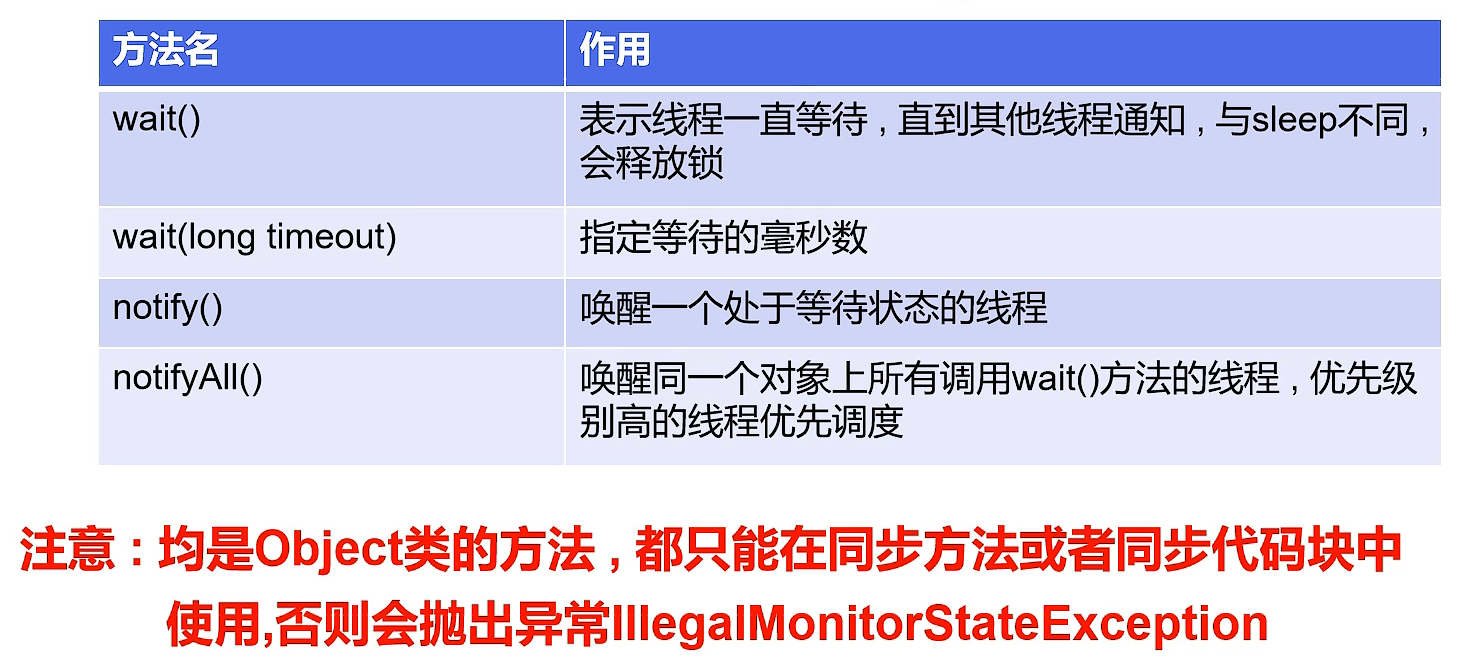
01 管程法
并发协作模型:生产者消费者模式-----> 管程法(增加缓冲区)
- 生产者:负责生产数据的模块(可能是方法,对象,线程,进程);
- 消费者:负责处理数据的模块(可能是方法,对象,线程,进程);
- 缓冲区:消费者不能直接使用生产者的数据,他们之间有个缓冲区;
生产者将生产好的数据放入缓冲区,消费者从缓冲区拿出数据
//测试:生产者消费者模型--->利用缓冲区解决:管程法 //生产者,消费者,产品,缓冲区 public class TestPC { public static void main(String[] args) { //创建一个容器 SynContainer container = new SynContainer(); new Producer(container).start(); new Consumer(container).start(); } } //生产者 class Producer extends Thread{ SynContainer container; public Producer(SynContainer container){ this.container = container; } //生产 @Override public void run() { for (int i = 0; i < 100; i++) { try { container.push(new Food(i)); } catch (InterruptedException e) { throw new RuntimeException(e); } System.out.println("生产了"+i+"个好吃的"); } } } //消费者 class Consumer extends Thread{ SynContainer container; public Consumer(SynContainer container){ this.container = container; } //消费 @Override public void run(){ for (int i = 0; i < 100; i++) { try { System.out.println("消费了--->"+container.buy().id+"个好吃的"); } catch (InterruptedException e) { throw new RuntimeException(e); } } } } //产品 class Food{ int id;//产品编号 public Food(int id) { this.id = id; } } //缓冲区 class SynContainer{ //需要一个容器大小 Food[] foods = new Food[10]; //容器计数器 int count = 0 ; //生产者放入产品 public synchronized void push(Food food) throws InterruptedException { //如果容器满了,就需要等待消费者消费 if(count==foods.length){ //通知消费者消费,生产者等待 this.wait(); } //如果没有满,就需要丢入产品 foods[count]=food; count++; //可以通知消费者消费了 this.notifyAll(); } public synchronized Food buy() throws InterruptedException { //判断能否消费 if(count==0){ //等待生产者生产,消费者等待 this.wait(); } //如果可以消费 count--; Food food = foods[count]; //吃完了,通知生产者生产 this.notifyAll(); return food; } }- 1
- 2
- 3
- 4
- 5
- 6
- 7
- 8
- 9
- 10
- 11
- 12
- 13
- 14
- 15
- 16
- 17
- 18
- 19
- 20
- 21
- 22
- 23
- 24
- 25
- 26
- 27
- 28
- 29
- 30
- 31
- 32
- 33
- 34
- 35
- 36
- 37
- 38
- 39
- 40
- 41
- 42
- 43
- 44
- 45
- 46
- 47
- 48
- 49
- 50
- 51
- 52
- 53
- 54
- 55
- 56
- 57
- 58
- 59
- 60
- 61
- 62
- 63
- 64
- 65
- 66
- 67
- 68
- 69
- 70
- 71
- 72
- 73
- 74
- 75
- 76
- 77
- 78
- 79
- 80
- 81
- 82
- 83
- 84
- 85
- 86
- 87
- 88
- 89
- 90
- 91
- 92
- 93
- 94
- 95
- 96
- 97
02 信号灯法
并发协作模型:生产者消费者模式-----> 信号灯法(设标志位)
//测试生产者消费者问题2:信号灯法-->标志位解决 public class TestPC2 { public static void main(String[] args) { TV tv = new TV(); new Player(tv).start(); new Watcher(tv).start(); } } //生产者--->演员 class Player extends Thread{ TV tv; public Player(TV tv){ this.tv = tv; } @Override public void run(){ for (int i = 0; i < 20; i++) { if(i%2==0){ try { this.tv.play("快乐大本营播放中"); } catch (InterruptedException e) { throw new RuntimeException(e); } }else{ System.out.println("广告时间。。。。"); } } } } //消费者--->观众 class Watcher extends Thread{ TV tv; public Watcher(TV tv){ this.tv = tv; } @Override public void run(){ for (int i = 0; i < 20; i++) { try { tv.watch(); } catch (InterruptedException e) { throw new RuntimeException(e); } } } } //产品--->节目 class TV{ //演员表演,观众等待 T //观众观看,演员等待 F String program ;//表演节目 boolean flag = true; //表演 public synchronized void play(String program) throws InterruptedException { if(!flag){ this.wait(); } System.out.println("演员表演--> "+program); //通知观众观看 this.notifyAll();//通知唤醒 this.program = program; this.flag = !this.flag; } //观看 public synchronized void watch() throws InterruptedException { if(flag){ this.wait(); } System.out.println("观看了"+program); //通知演员表演 this.notifyAll(); this.flag = !this.flag; } }- 1
- 2
- 3
- 4
- 5
- 6
- 7
- 8
- 9
- 10
- 11
- 12
- 13
- 14
- 15
- 16
- 17
- 18
- 19
- 20
- 21
- 22
- 23
- 24
- 25
- 26
- 27
- 28
- 29
- 30
- 31
- 32
- 33
- 34
- 35
- 36
- 37
- 38
- 39
- 40
- 41
- 42
- 43
- 44
- 45
- 46
- 47
- 48
- 49
- 50
- 51
- 52
- 53
- 54
- 55
- 56
- 57
- 58
- 59
- 60
- 61
- 62
- 63
- 64
- 65
- 66
- 67
- 68
- 69
- 70
- 71
- 72
- 73
- 74
- 75
- 76
- 77
- 78
- 79
- 80
- 81
08 线程池
背景:经常创建和销毁、使用量特别大的资源,比如并发情况下的线程,对性能影响很大;
思路:提前创建好多个线程,放入线程池中,使用时直接获取,使用完放回池中;
好处:
- 提高响应速度(减少了创建新线程的时间);
- 降低资源消耗(重复利用线程池中线程,不需要每次都创建);
- 便于线程管理:
- corePoolSize :核心池的大小
- maximumPoolSize :最大线程数
- keepAliveTime :线程没有任务时最多保持多长时间后会终止
使用线程池:
- JDK5.0起提供了线程池相关的API:ExecutorService 和 Executors
- ExecutorService :真正的线程池接口。常见子类 ThreadPoolExcecutor
- void execute (Runnable command) :执行任务/命令,没有返回值,一般用来执行Runnable
Future submit(Callable task):执行任务,有返回值,一般用来执行Callable - void shutdown() :关闭线程池
- Executors :工具类、线程池的工厂类,用于创建并返回不同类型的线程池
import java.util.concurrent.ExecutorService; import java.util.concurrent.Executors; //测试线程池 public class TestPool { public static void main(String[] args) { //1.创建服务,创建线程池 //newFixedThreadPool 参数为线程池大小 ExecutorService service = Executors.newFixedThreadPool(10); service.execute(new MyThread()); service.execute(new MyThread()); service.execute(new MyThread()); service.execute(new MyThread()); service.execute(new MyThread()); //2.关闭链接 service.shutdown(); } } //线程类实现Runnable接口 class MyThread implements Runnable{ @Override public void run(){ System.out.println(Thread.currentThread().getName()); } }- 1
- 2
- 3
- 4
- 5
- 6
- 7
- 8
- 9
- 10
- 11
- 12
- 13
- 14
- 15
- 16
- 17
- 18
- 19
- 20
- 21
- 22
- 23
- 24
- 25
- 26
- 27
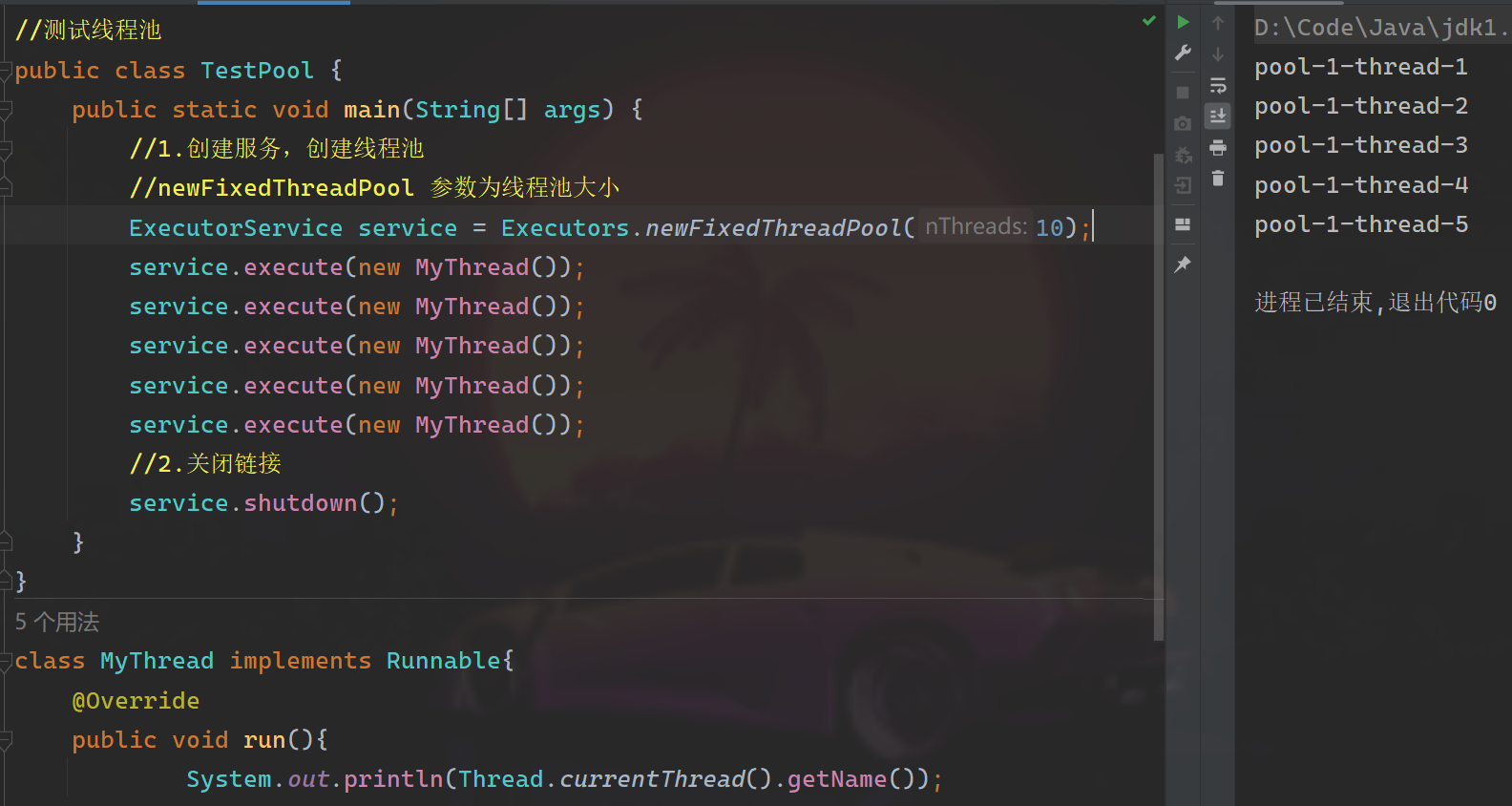
-
相关阅读:
鸿鹄工程项目管理系统 Spring Cloud+Spring Boot+前后端分离构建工程项目管理系统
express学习6-express参数中get参数的获取
[ESP32 IDF+Vscode]OLED多级菜单显示(摇杆控制)
day42 62.不同路径 63. 不同路径 II
Ensembling Off-the-shelf Models for GAN Training(GAN模型迎来预训练时代,仅需1%的训练样本)
Java实现单链表
xxl-job学习
p38 2带头结点单链表删除所有x元素
Docker安装MongoDB
基于R语言分位数回归丨线性回归假设与分位数函数、线性分位数回归 、贝叶斯分位数回归、超越线性分位数回归等
- 原文地址:https://blog.csdn.net/Lov1_BYS/article/details/128007355
